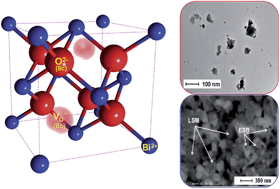Highly functional nano-scale stabilized bismuth oxides via reverse strike co-precipitation for solid oxide fuel cells
Abstract
Nano-scale erbia stabilized bismuth oxides (ESBs) were successfully synthesized by a wet chemical reverse strike co-precipitation. Due to homogenous, molecular level mixing, the desired cubic fluorite structure was formed at a dramatically reduced temperature of 500 °C, which was confirmed by X-ray diffraction and Raman spectroscopy. Moreover, this low calcine temperature led to nano-scale ESB powders with a crystallite size of ∼20 nm and a specific surface area of ∼13.2 m2 g−1. Due to the high surface area, the nano-sized ESB powders show high functionality for solid oxide fuel cell (SOFC) applications. As an SOFC electrolyte, the high sinterability of the co-precipitated ESB was demonstrated, achieving over 98% density after sintering at only 750 °C for 30 min. Moreover, the total conductivity of the sample was identical to that obtained by conventional methods after sintering at 890 °C (for 16 h), regardless of the different grain boundary densities. In addition, the co-precipitated ESB was used in a composite cathode with lanthanum strontium manganite (LSM), achieving significantly reduced cathodic ASRs, 0.55 and 0.03 Ω cm2, at 550 and 700 °C by extending triple phase boundary (TPB) lengths in the cathode bulk and at the cathode–electrolyte interface.


 Please wait while we load your content...
Please wait while we load your content...